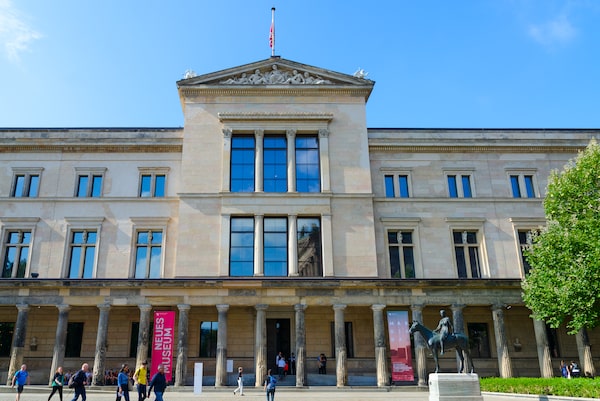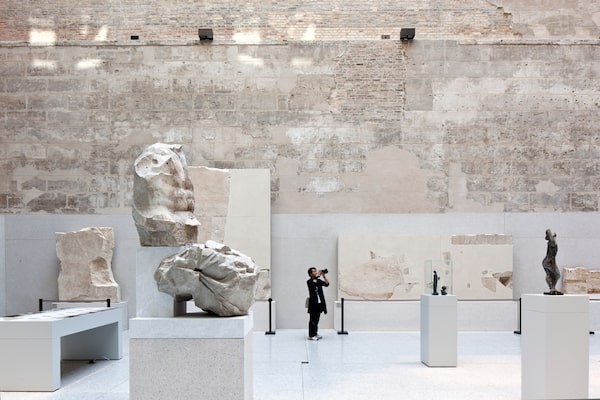
New Museum on famous Museum Island, Berlin.iStockPhoto / Getty Images
In Berlin, history is always with you. Walking the streets of the Mitte district, it’s easy to settle into the city’s modern bustle: coffee and cocktails, indie bookstores uneasily sharing space with online-first fashion labels. Then you notice the shrapnel damage that pockmarks the stone walls.
Every city contains layers of the past, but none more dramatically so than the German capital. And the city’s Museum Island provides an ideal point to reflect on this theme, following a new set of buildings that rethink and extend its legacy.
Today’s vibrant, prosperous and diverse Berlin is marbled with reminders of the recent, dark past. On my visit this July, I stayed at the newly renovated boutique hotel the Weinmeister and explored the neighbourhood around Hackescher Markt.
A hub for Berlin’s nightlife, it contains the Hackesche Hoefe complex. This group of 1906 loft buildings encloses eight courtyards, lined with colourful Jugendstil mosaics, which guide visitors into its 40 restaurants and cafés, boutiques and an upstairs cinema.
After some tapas and Rioja, I left the complex and stumbled across a memorial in an old Jewish cemetery that marks another chapter in the neighbourhood’s history: a sculpture by Will Lammert memorializing Jewish victims of Nazi genocide. This area on Grosse Hamburger Strasse is also the site of a retirement home from which the Nazis deported more than 50,000 Jewish Berliners to death camps.
Such fault lines between past and present animate Museum Island, a kilometre away. This acropolis of five museums in the middle of the Spree River dates back to 1830, when what is now the Altes Museum opened to the public. Today it houses a grand antiquities collection in galleries that surround a central rotunda – which was destroyed by Allied bombs in 1945 and rebuilt by East German authorities. Its grand colonnade was admired by Hitler but also by the Modernist architect Mies van der Rohe, whom the Nazis forced into exile. The scars of war remain visible in the museum’s Ionic columns, which are being restored as part of a long-term renovation.

Museum Island provides an ideal point to reflect on this theme, following a new set of buildings that rethink and extend its legacy.Ute Zscharnt/Handout
Those columns are echoed by new columns in the James Simon Gallery next door, designed by the U.K.’s David Chipperfield Architects, who won the 2023 Pritzker Architecture Prize.
That structure, which opened just before the pandemic, provides a shared entrance building for the entire complex. Walls and colonnades of brilliant white concrete, studded with flocks of white Saxon marble, refer to the humanist aspirations of 19th-century neoclassicism with a subtle, ascetic Modernism.
But nearby stands one of the world’s greatest works of architectural restoration: the Neues Museum. Completed in 1859 by the architect Friedrich August Stüler, the museum was bombed in 1945 and collapsed into a picturesque ruin. In 1997, a design competition was held to rethink the building; Chipperfield’s office won with a nuanced design approach that leaves the old intact and adds to it, without disguising the stitches or the scars.
The museum today holds a major collection of antiquities, including a bust of Queen Nefertiti, which is one of the island’s major attractions. But Chipperfield’s interventions are artworks themselves. Half-destroyed frescos on Enlightenment themes frame Etruscan pottery. Broken plaster is patched up with new concrete, the jagged seams tracing a line between past and present. Roman sarcophagi bask in the sunlight between double-height walls of bullet-pocked stone and new concrete.
And in a central stairway, Chipperfield and colleagues have employed recycled brick and terracotta in a huge, irregular patchwork. Smooth concrete stairs ascend through this lofty space. The architecture embodies the ideals of the museum while making it clear that, in Berlin and in Germany, those universal and humanist aims once went badly wrong. The architect Chipperfield once wrote that the debate around restoring buildings in Berlin is “a complex cocktail of emotion and intellect,” with “conflicting desires to remove the rubble and the memories and the desire to put back what was lost.” That cocktail is sometimes bitter; it is never boring.
The author was a guest of the German National Tourist Office. It did not review or approve the story before publication.
 Alex Bozikovic
Alex Bozikovic